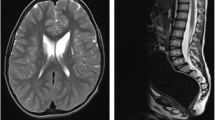Abstract
Purpose
Selective dorsal rhizotomy (SDR) is a neurosurgical procedure used to treat spasticity in children with cerebral palsy (CP). The vast majority of studies to date suggest SDR is particularly effective in reducing lower limb spasticity in spastic diplegia with long-lasting effect.
Method
We report, to the best of our knowledge for the first time, the case of a teenager who underwent SDR for the management of spasticity secondary to transverse myelitis.
Results
This is an unusual indication for SDR which resulted in completely loose lower limbs and an excellent functional outcome. At a follow-up 18 months following the procedure, the child had no re-occurrence of his symptoms.
Conclusion
This report raises the possibility that the use of SDR could be expanded to include other pathologies. We discuss the case and the relevant literature. Our spasticity service at NUH has to date inserted 300 baclofen pumps and performed 60 SDRs mainly in children with cerebral palsy.

Similar content being viewed by others
References
Mandigo CE, Anderson RC (2006) Management of childhood spasticity: a neurosurgical perspective. Pediatr Ann 35(5):354–362
Trost JP, Schwartz MH, Krach LE, Dunn ME, Novacheck TF (2008) Comprehensive short-term outcome assessment of selective dorsal rhizotomy. Dev Med Child Neurol 50(10):765–771
Mittal S, Farmer JP, Al-Atassi B et al (2002) Long-term functional outcome after selective posterior rhizotomy. J Neurosurg 97(2):315–325
Yang TF, Lee SS, Lin PH, Chen H, Chan RC (2002) Effect of selective posterior rhizotomy on transverse myelitis in a patient with systemic lupus erythematosus. Am J Phys Med Rehabil 81(6):467–468
Nordmark E, Josenby AL, Lagergren J, Andersson G, Stromblad LG, Westbom L (2008) Long-term outcomes five years after selective dorsal rhizotomy. BMC Pediatr 8:54
van Schie PE, Schothorst M, Dallmeijer AJ et al (2011) Short- and long-term effects of selective dorsal rhizotomy on gross motor function in ambulatory children with spastic diplegia. J Neurosurg Pediatr 7(5):557–562
Engsberg JR, Ross SA, Wagner JM, Park TS (2002) Changes in hip spasticity and strength following selective dorsal rhizotomy and physical therapy for spastic cerebral palsy. Dev Med Child Neurol 44(4):220–226
Tedroff K, Lowing K, Jacobson DN, Astrom E (2011) Does loss of spasticity matter? A 10-year follow-up after selective dorsal rhizotomy in cerebral palsy. Dev Med Child Neurol 53(8):724–729
Josenby AL, Wagner P, Jarnlo GB, Westbom L, Nordmark E (2012) Motor function after selective dorsal rhizotomy: a 10-year practice-based follow-up study. Dev Med Child Neurol 54(5):429–435
Subramanian N, Vaughan CL, Peter JC, Arens LJ (1998) Gait before and 10 years after rhizotomy in children with cerebral palsy spasticity. J Neurosurg 88(6):1014–1019
Dudley RW, Parolin M, Gagnon B et al (2013) Long-term functional benefits of selective dorsal rhizotomy for spastic cerebral palsy. J Neurosurg Pediatr 12(2):142–150
Langerak NG, Tam N, Vaughan CL, Fieggen AG, Schwartz MH (2012) Gait status 17–26 years after selective dorsal rhizotomy. Gait Posture 35(2):244–249
Langerak NG, Lamberts RP, Fieggen AG, Peter JC, Peacock WJ, Vaughan CL (2009) Functional status of patients with cerebral palsy according to the international classification of functioning, disability and health model: a 20-year follow-up study after selective dorsal rhizotomy. Arch Phys Med Rehabil 90(6):994–1003
Oki A, Oberg W, Siebert B, Plante D, Walker ML, Gooch JL (2010) Selective dorsal rhizotomy in children with spastic hemiparesis. J Neurosurg Pediatr 6(4):353–358
Gump WC, Mutchnick IS, Moriarty TM (2013) Selective dorsal rhizotomy for spasticity not associated with cerebral palsy: reconsideration of surgical inclusion criteria. Neurosurg Focus 35(5):E6
Conflict of interest
The authors declare no conflict of interests.
Author information
Authors and Affiliations
Corresponding author
Rights and permissions
About this article
Cite this article
Mazarakis, N.K., Ughratdar, I. & Vloeberghs, M.H. Excellent functional outcome following selective dorsal rhizotomy in a child with spasticity secondary to transverse myelitis. Childs Nerv Syst 31, 2189–2191 (2015). https://doi.org/10.1007/s00381-015-2779-2
Received:
Accepted:
Published:
Issue Date:
DOI: https://doi.org/10.1007/s00381-015-2779-2




